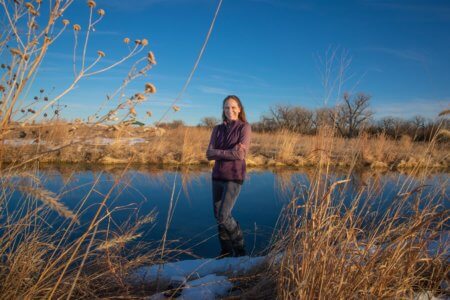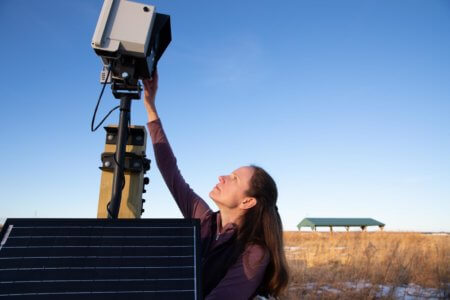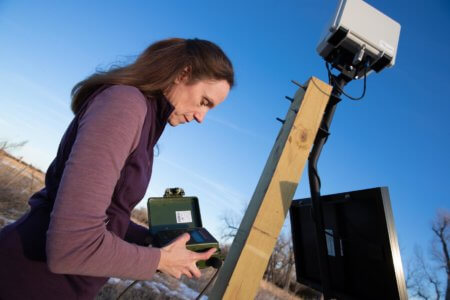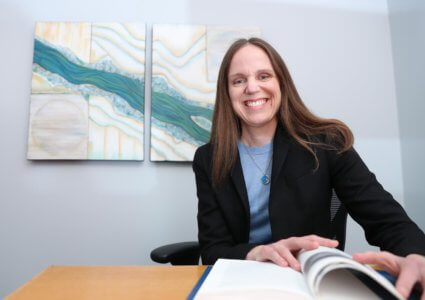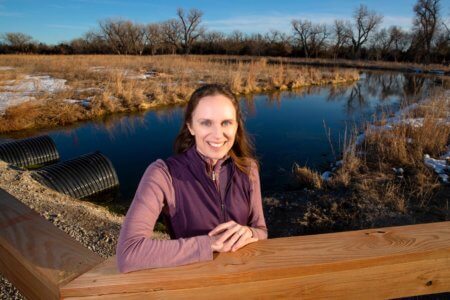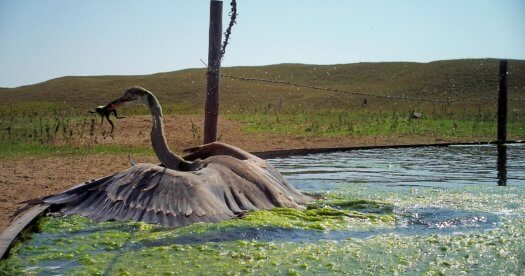See more about creative collaborations related to watersheds at WitnessingWatersheds.com and PlatteBasinTimelapse.com

By KIM HACHIYA
The most interesting things seem to happen at the edges where two disparate entities meet.
A seed touches the soil; a city creeps into the country; a river rubs against the bank. The proximity triggers all sorts of reactions that scientists love to explore. They sometimes observe them in labs, manipulating environments in a test tube or predicting outcomes using computer models. But some systems are too big to study inside the lab – then maybe the lab goes outdoors.
A river system is like that.
A watershed that drains thousands of square miles is just too big to see what individual events can cause. But what if you could study river ecosystems over a long period of time, comparing changes you can see, trying to deduce what induced those changes? That’s what Mary Harner does. And this scientist adds a new wrinkle – she’s also an accomplished communicator, so she not only knows the science, she can tell others, too, using photographs and other visualizations to exchange knowledge and educate others about her favorite environment – rivers.
Kearney, Nebraska, Harner notes, is a great place for someone who likes to study rivers. The Platte River flows nearby, and the Platte plays a prominent role in her research. Harner came to Nebraska in 2008. Her husband, biologist Keith Geluso, had joined the University of Nebraska at Kearney faculty, and soon after she began a shared position as an assistant professor of biology at UNK and as wetland ecologist for the Crane Trust. In 2012, she was named director of science for the Crane Trust and in 2015 joined UNK as a research associate professor. Since 2016, she has been an associate professor in the departments of communication and biology. The dual appointment is unusual, she acknowledges, and is a recurring theme of those intersecting edges that fascinate Harner.
“What I have come to really appreciate about the Platte and other rivers is the edges, the ecotones,” she said.
Ecotones are a region of transition between two biological communities, such as the river and the shore. Ecotones often are richer in species and variations than either of the two habitats alone. Harner is especially interested in sloughs, the linear depressions on the edges of the river through which water periodically pulses – creating floods, drylands, wetlands. The slough’s boundaries constantly change as the river ebbs and flows. This, she notes, creates a lot of interesting situations for the plants and animals that live there.
Harner grew up on the banks of the Mississippi River in Alton, Illinois, near the Mississippi’s confluence with the Missouri River. While her family lived on the high bluff, her father’s pharmacy was downtown, near the river. And in 1993, when both the Missouri and Mississippi rivers experienced devastating floods, the town of Alton was hard hit, leaving an impression on Harner.
She later went to Tulane University in New Orleans (another river town, which she notes is also a recurring theme in her life), intending to study biomedical engineering. But a class in ecology her sophomore year changed her trajectory. After earning her bachelor’s degree in ecology, evolution and organismal biology, she headed to the University of Montana to pursue a master’s in environmental studies. There, she studied a freely flowing river and had the chance to see how a river with dynamic flows interacts with its floodplain. After earning her master’s, she went on to earn her doctorate in biology from the University of New Mexico in an interdisciplinary doctoral program in freshwater sciences.
In her early research, she was particularly drawn to cottonwood trees, in part because they reminded her of home in Illinois. In Montana, she studied a dynamic river system that flowed near Glacier National Park and looked at cottonwood tree rings and historic aerial photographs showing the Flathead River floodplains. Later, she studied soil fungi that live among cottonwood roots, looking at how the fungi’s properties affected the soil biome and other plants. This, she notes, is another recurring theme – looking at what’s happening above and below ground and the interaction of edges. That work required taking photographs below ground to capture visually the changes occurring with roots. Those photos, she notes, were not very exciting for non-scientists to look at.

PLATTE TIMELAPSE PROJECT
The Rio Grande has endured centuries of human intervention and interactions, she said. It’s in some sense an urban river; with headwaters in Colorado it flows near Albuquerque, New Mexico, then veers into Texas. The river comprises part of the border between the United States and Mexico. The influence of humans on the river is unending as both indigenous people and European settlers have relied on the river.
Harner used historical aerial photos of the Rio Grande as it passes through Albuquerque to track changes in the river channel and human encroachment into a once wild river floodplain.
“It was there I started to see the power of the historical context,” she said, “how things that are hard to see in real time can be seen when you compare data from an image. You get a more complete story.”
And, she notes, because we live in a visual society, images help reach different audiences.
While at the Crane Trust, Harner became involved in the then-emerging Platte Basin Timelapse Project, a long-term, multimedia documentary project focused on the Platte River watershed, which encompasses more than 90,000 square miles in Colorado, Wyoming and Nebraska. Platte Basin Timelapse, co-founded by Michael Forsberg and Michael Farrell, is based at the Center for Great Plains Studies at the University of Nebraska-Lincoln. The hallmark of the project is the permanent placement of more than 60 cameras along key points in the watershed. Each camera takes one photograph per daylight hour, 365 days a year. The project has more than 2 million photos in its archives, which are ripe for study by scientists and others interested in how the river changes over time and how the environments through which the river flows are changing.
Harner realized the time-lapse methodology was a powerful tool for science and communication, and she is using its methods to study other river systems, particularly the Gila River, which like the Platte has sustained long-term human use, although it’s in a much wilder state.
In 2018, Harner received a National Science Foundation research fellowship, awarded through the federal Established Program to Stimulate Competitive Research (EPSCoR), to fund collaboration between UNK and the University of New Mexico to learn about river systems, and communicate rivers’ importance to public audiences. The Platte, Gila and Rio Grande rivers are the foci of the project. The project looks at historic and current influences on water-use decisions and the drivers of change across river basins, highlighting connections within and across these systems.
Harner and an early career researcher at UNK, Emma Brinley Buckley, are applying digital technologies such as time-lapse cameras and sound recorders to document the rivers’ ecosystems and collect ecological data. Harner and Brinley Buckley are using the information to help public audiences understand the importance of rivers, watersheds and floodplain systems. The project is expected to last about two years.
“People are searching for ways to manage rivers to meet societal and ecosystem needs as human populations and demands for freshwater increase globally,” Harner said. “Communication among diverse stakeholders is necessary for achieving solutions for how to simultaneously utilize and protect freshwater resources.”
The digital media produced will be shared with a range of audiences to determine how people respond to and learn from various forms of scientific content, with an ultimate goal of developing a deeper connection between people and river systems. Fellowship activities will transform ongoing research at the University of Nebraska and provide opportunities for students to access information, approaches and skills to understand and describe the changing world and prepare for careers that increasingly focus on working in teams across disciplinary – and watershed – boundaries.
The project will expand ongoing research and science communication activities taking place across University of Nebraska campuses, particularly with Platte Basin Timelapse.
Harner and Brinley Buckley have a robust web presence at www.witnessingwatersheds.com. There, some of the projects developed under the EPSCoR grant are publicly available.
While this and other research projects are exciting for Harner, she said the most rewarding part of her career is the chance to introduce students to the natural world. The proximity of the Platte to UNK’s campus means that the field season (the time that researchers and students can be “in the field” rather than the lab) is not limited solely to summer or short-term experiences. The river is there every day and is easily accessible as a year-round open-air laboratory.
So, she hopes to instill wonder and feed students’ curiosity about the natural world while still teaching them the fundamentals of science – data collection, data management, data analysis. She wants to connect students to teams and show them how to see the big picture and the entire ecosystem through various lenses.
“At the edges of where the disciplines intersect, I want our students to have opportunities and the foundational language and skills to move across those disciplines,” she said. “There is tremendous opportunity to grow in the areas of science communication. Most of my students are biology undergraduates, but students from geography, English, filmmaking are also seeking out these experiences and training.”

IMAGES WITH SOUND
Inspiring curiosity in today’s undergraduates can be challenging, but Harner says that at some level, all students have an innate curiosity about their world. Her job, she says, is to expose them to places, to ways of thinking and to collaborative activities that they might not find on their own.
“This is where their curiosity can operate.”
For example, she and her spouse have taken students to the Nebraska Sandhills – home for some students but an almost foreign environment for others. “But there, students observe the wonder, the beauty. We are so lucky to be in natural areas that are so awe-inspiring. Curiosity works quickly in such an environment.”
Harner is passionate about instilling in her students the ability to work collaboratively and in teams. That’s a foundational skill for scientists, she notes, and for all other disciplines as well. “Students need to work in teams, in communities and across boundaries. People are not separate from the environment. So, we need to learn how to work together, to respect each other and each other’s abilities, based on our commonalities, not our differences. It can be hard to navigate, but it’s important for our students to see that happen.”
Harner herself has benefitted from collaborations. The EPSCoR grant is an example, but she also has benefitted from the University of Nebraska’s Collaboration Initiative, which strengthens links between and among the four NU campuses. She is a fellow with UNL’s Center for Great Plains Studies, a fellow with the Daugherty Water for Food Institute and has done work with scientists at UNL’s Center for Virology and with UNL engineers looking to create an artificial intelligence (AI) that would automate image analysis to figure out what’s happening in those thousands of timelapse images.
One collaboration found her live streaming an electronic field trip undertaken at a Sandhills ranch to middle and high school students in classrooms across the state. Another led to a study of how birds and animals reacted to the 2017 total eclipse that crossed Nebraska. Her most recent focus is to add sound to the images.
“Sound is a very powerful tool, and to add sounds to a presentation adds a new layer of information. You can see audiences respond as they perceive new things when sound is added to images.”
Adding sound to the time-lapse images will enrich the Platte Basin time-lapse data set, she said. Sound is a rich data source for scientists, allowing them to study the timing of animal activity. For example, sometimes one can hear cranes, waterfowl or frogs on the Platte in the springtime before the cameras actually photograph them.
While many digital media productions about rivers, prairies, mountains and the natural world seem to focus on beauty, Harner said that’s just one way to begin to engage audiences.
“We always start presentations with the question of why. Why care about rivers? About prairies? We may start with beauty, but sometimes the things that matter are not that captivating. But we are all connected, and it’s important to come to know that. As we make decisions, we need to know what the consequences might be if we sever those connections. We need to be cautious and informed in making those decisions.
“At the core of what we are doing is building relationships and understanding of ecosystem connections through interdisciplinary research, student training and public communication,” she said. “It’s a very rewarding intersection of fields.”

Mary Harner
Title: Associate Professor
College: Arts and Sciences
Department: Communication and Biology
Education: Ph.D., Biology, University of New Mexico, 2006; Master of Science, Environmental Studies, University of Montana, 2001; Bachelor of Science, Ecology, Evolution, and Organismal Biology, Tulane University, 1997.
Years at UNK: 7
Areas of research/specialization: Ecosystem ecology, river and wetland ecology and science communication. Focus is ecological research and communication about rivers, landscape and place, including how rivers interact with landscapes over time, ecotones between terrestrial and aquatic systems, and connections between human and natural systems.
